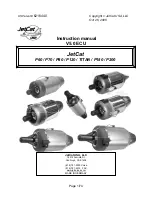
The lubricity of these fuels must not exceed wear scar
diameter of 0.52 mm (0.0205 inch). The fuel lubricity
test must be performed on an HFRR, operated at
60 °C (140 °F). Refer to ISO 12156-1.
NOTICE
The fuels system has been qualified with fuel having
lubricity up to 0.52 mm (0.0205 inch) wear scar diam-
eter as tested by ISO 12156-1. Fuel with higher wear
scar diameter than 0.52 mm (0.0205 inch) will lead to
reduced service life and premature failure of the fuel
system.
Fuel additives can enhance the lubricity of a fuel.
Contact your fuel supplier for those circumstances
when fuel additives are required. Your fuel supplier
can make recommendations for additives to use, and
for the proper level of treatment.
Distillation
Distillation is an indication of the mixture of different
hydrocarbons in the fuel. A high ratio of light weight
hydrocarbons can affect the characteristics of
combustion.
Classification of the Fuels
Diesel engines have the ability to burn wide variety of
fuels. The following list of typically encountered fuel
specifications that have been assessed as to their
acceptability and are divided into following
categories:
Group 1: Preferred fuels
Following fuel specifications are considered
acceptable
• Fuels meeting the requirements of the "Perkins
Specification for Distillate Diesel Fuel" listed in the
Table 17 .
• EN590 - Grades A to F and class 0 to 4
• ASTM D975 Grade No. 1-D and 2-D
• JIS K2204 Grades 1, 2 & 3 & Special Grade 3
acceptable provides lubricity ware diameter does
not exceed of 0.46 mm (0.01811 inch)ISO 12156-
1
• BS2869-Class A2 Off Highway Gas Oil, Red
Diesel
Note:
The lubricity of these fuels must not exceed
wear scar diameter of 0.52 mm (0.02047 inch) as per
ISO 12156-1. Refer to the lubricity section within the
Fuel Recommendation Section.
Group 3 Biodiesel Fuel
Recommendation for Biodiesel
Biodiesel is a fuel that can be defined as mono-alkyl
esters of fatty acids . Biodiesel is a fuel that can be
made from various feedstock. The most commonly
available biodiesel in Europe is Rape Methyl Ester
(RME). This biodiesel is derived from rapeseed oil .
Soy Methyl Ester (SME) is the most common
biodiesel in the United States. This biodiesel is
derived from soybean oil . Soybean oil or rapeseed
oil are the primary feedstocks. These fuels are
together known as Fatty Acid Methyl Esters (FAME) .
Raw pressed vegetable oils are NOT acceptable for
use as a fuel in any concentration in compression
engines . Without esterification, these oils solidify in
the crankcase and the fuel tank. These fuels may not
be compatible with many of the elastomers that are
used in engines that are manufactured today. In
original forms, these oils are not suitable for use as a
fuel in compression engines . Alternate base stocks
for biodiesel may include animal tallow , waste
cooking oils , or various other feedstocks. In order to
use any of the products that are listed as fuel, the oil
must be esterified .
Fuel made of 100 percent FAME is generally referred
to as B100 biodiesel or neat biodiesel.
Biodiesel can be blended with distillate diesel fuel.
The blends can be used as fuel. The most commonly
available biodiesel blends are B7, which is 7 percent
biodiesel and 95 percent distillate diesel fuel. B20,
which is 20 percent biodiesel and 80 percent distillate
diesel fuel.
Note:
The percentages given are volume-based.
The U.S. distillate diesel fuel specification ASTM
D975-09a includes up to B7 (7 percent) biodiesel.
European distillate diesel fuel specification EN590:
2010 includes up B7 (7 percent) biodiesel.
Note:
Engines that are manufactured by Perkins are
certified by use of the prescribed Environmental
Protection Agency (EPA) and European Certification
fuels. Perkins does not certify engines on any other
fuel. The user of the engine has the responsibility of
using the correct fuel that is recommended by the
manufacturer and allowed by the EPA and other
appropriate regulatory agencies.
Specification Requirements
The neat biodiesel must conform to the latest
EN14214 or ASTM D6751 (in the USA). The
biodiesel can only be blended in mixture of up to 20%
by volume in acceptable mineral diesel fuel meeting
latest edition of EN590 or ASTM D975 S15
designation.
62
SEBU8731
Refill Capacities
Fluid Recommendations
Содержание 1106C-70TA
Страница 102: ...102 SEBU8731 Index Section...
Страница 104: ...2013 Perkins Engines Company Limited All Rights Reserved...
















































